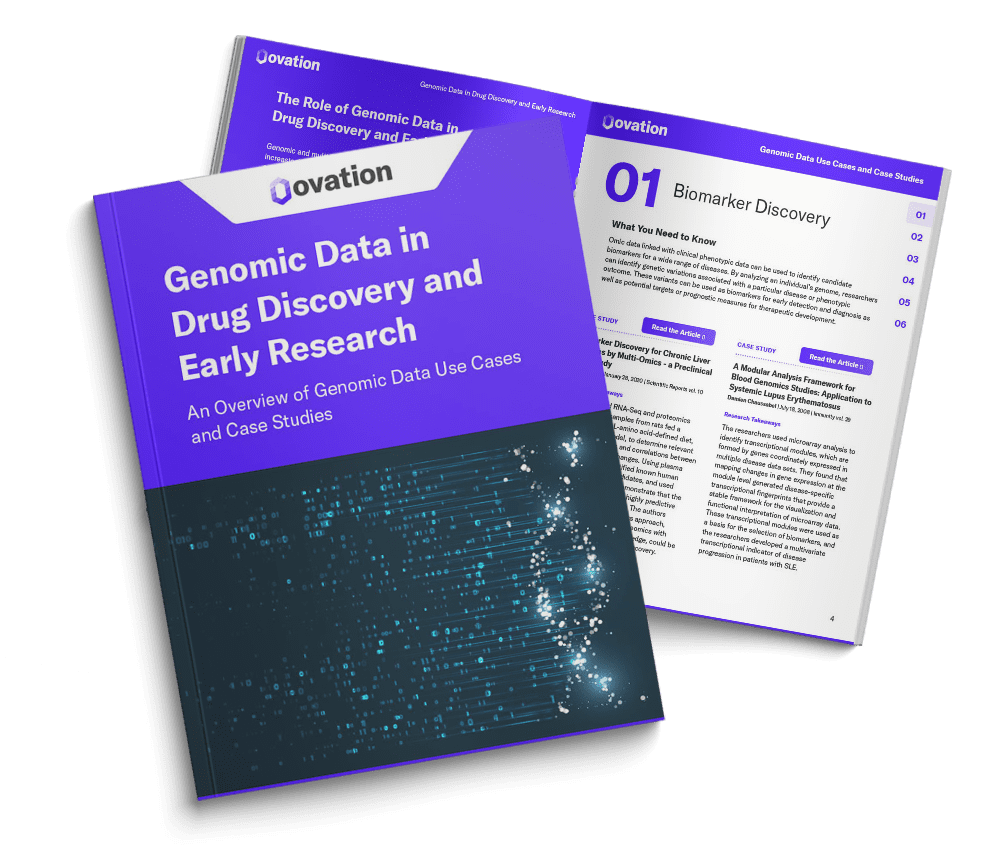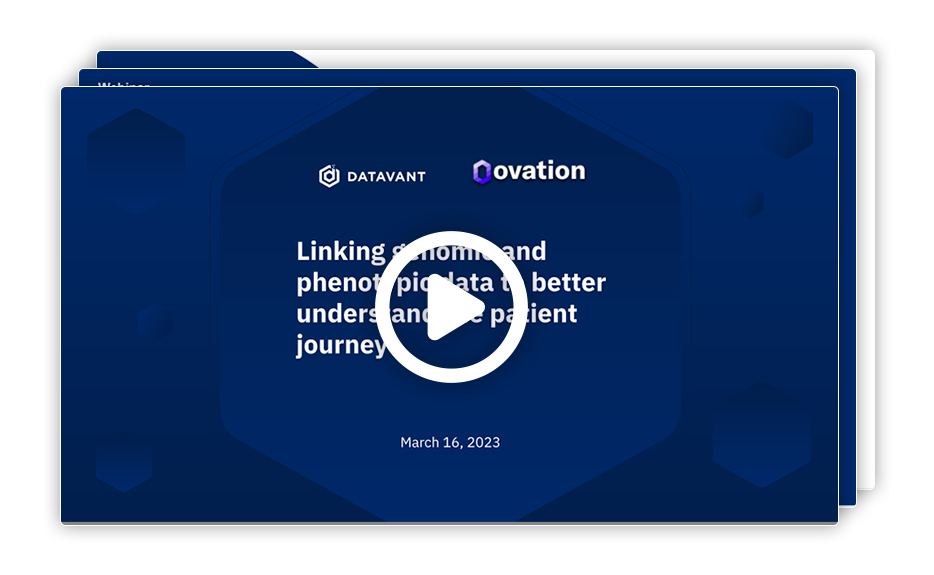Our recent eBook extensively covered the emerging role of genomic data in drug discovery, with a spotlight on six specific applications spanning from biomarker discovery to patient stratification. This piece narrows the focus to biomarker discovery for precision medicine, highlighting the burgeoning use of omics data to expedite advancement in therapeutic areas beyond oncology.
Omics biomarkers provide researchers with an understanding of disease mechanisms, paving the way for superior diagnostics and therapies. Omics data offers new opportunities to uncover these molecular signatures that underpin disease, fostering advancements in disease diagnosis, prognosis, progression, and treatment response.
This article covers recent strides in the domain of omics biomarker discovery outside of the realm of oncology, and the potential roles that omics datasets could play to propel this field further.
Unraveling Precision Diagnostics for Coronary Artery Disease
Heart disease is the leading cause of death in the United States, claiming over 695,000 lives annually. Coronary Artery Disease (CAD), the most common form of heart disease, accounted for nearly 375,476 deaths in 2021 alone. Diagnosing CAD among individuals reporting signs or symptoms such as chest pain remains challenging. Coronary angiography is considered the standard procedure, but it’s invasive and potentially harmful.
Gene expression analysis has emerged as a promising method of assessing disease risk; 23 genes have been identified and used as constituents in gene expression score (GES) test algorithms (Lanksy, et al). Despite the commercial discontinuation of the first diagnostic test (CORUS CAD test) employing these methods, further gene expression analysis has brought significant progress. A notable study found that 61 genes exhibited differing expression in lesions of different severities, a substantial finding with the potential to develop gene expression CAD diagnostics with high clinical utility (Lapado, et al).
Detecting Rheumatoid Arthritis Disease Activity
Rheumatoid arthritis (RA) is a chronic autoimmune disease affecting the joints, with varying severity among patients. Approximately 1.3 million adults suffer from RA. Timely diagnosis and assessment of disease severity are paramount, allowing for prompt treatment initiation before disease progression culminates in irreversible joint damage.
The Vectra DA test stands as the first and only multi-biomarker test validated to measure RA inflammatory disease activity, employing blood serum samples to measure concentrations of 12 protein biomarkers associated with RA. The Vectra DA score demonstrated high predictive power in estimating a standard RA disease activity score, which was later adjusted for age, gender, and adiposity (Brahe, et al).
Additionally, recent discoveries have revealed that the rheumatoid factor (RF) antibody in combination with C-reactive protein (CRP) predicts disease activity, bone erosion, and cartilage damage. Anti-cyclic citrullinated protein (Anti-CCP) can also be used to determine the diagnosis and predict the recurrence of RA. In all these biomarkers, the 14-3-3η protein was found to enhance diagnostic accuracy (Abdelhafiz, et al).
Transcriptomic studies have also led to breakthroughs in RA disease activity detection. For example, RNA sequencing analysis on synovial tissue samples from patients with RA and osteoarthritis (OA) has revealed differentially expressed genes (DEGs) that could potentially be used as biomarkers for the diagnosis of these diseases (Zhang, et al).
Screening for Alzheimer’s Disease
Clinically approved diagnostic and prognostic omics-derived tests for Alzheimer’s Disease (AD) are yet to be established. Finding biomarkers in the blood—a significantly more accessible sampling methodology than cerebrospinal fluid (CSF)—has been particularly difficult. Nonetheless, the development of novel ultrasensitive immunoassay and mass spectrometry methods offers promise for blood biomarkers with potential applications as screening tools. For instance, a recent study discovered that plasma neurofilament light (NFL) was increased in patients with AD and could serve as a noninvasive biomarker (Mattsson, et al).
Non-alcoholic Fatty Liver Disease Diagnosis and Staging
Non-alcoholic fatty liver disease (NAFLD), affecting roughly 25% of the general population, can escalate toward more serious disease stages, including non-alcoholic steatohepatitis (NASH), cirrhosis, fibrosis, and hepatocellular carcinoma (HCC). Despite its high prevalence, NAFLD is still difficult to diagnose without an invasive liver biopsy. However, recent research has revealed promising novel biomarkers that were discovered through omics approaches. For example, a recent study analyzed the value of serum microRNAs in predicting NAFLD severity, revealing nine of them as specific for NAFLD (López-Riera, et al).
Inflammatory Bowel Disease Diagnostic Tools
Inflammatory Bowel Disease (IBD), encompassing Crohn’s disease (CD) and ulcerative colitis (UC), is a chronic, often debilitating condition that affects about 7 million people worldwide. One of the central challenges with IBD lies in its unpredictable course: patient symptoms vary, and reliable, noninvasive diagnostic tools are absent. This is where biomarker discovery research has the potential to revolutionize IBD treatment and management.
Specific gene expression profiles have demonstrated utility in IBD prognosis. A recent study used RNA sequencing to characterize gene expression of CD in biopsy specimens. The researchers developed a transcriptional risk score that shows promise in not only identifying patients with CD, but also those likely to progress to complicated disease (Marigorta, et al). A commercially available transcriptional signature in peripheral CD8 T cells associated with T cell exhaustion (PredictSURE) further exhibits promising initial results as a potential predictor of more aggressive disease (Biasci, et al).
Expanding the Role of Omics Data in Biomarker Discovery
We are witnessing rapid advancements in biomarker discovery research, partly due to the creation and application of omics datasets. Here, we highlight pivotal ways in which omics datasets will continue to propel this field.
Applying advanced machine learning modules to omics datasets to refine biomarker specificity
Patient heterogeneity can make precision medicine particularly challenging for complex diseases. One way researchers are addressing this is by applying advanced machine learning algorithms to omics datasets. For example, a recent study used a machine learning workflow to define different biomarkers for pediatric patients with CD and other GI tract conditions by integrating patient clinical data with microbiome profiles (Gevers, et al). This type of specificity offers the potential to create better, targeted diagnostics and therapies.
Translating omics biomarkers to clinical applications
Another application of advanced machine learning modules is in bridging the gap from biomarker to clinical utility. The field of oncology has seen success here with the Onctoype DX test, which was developed using a machine learning algorithm to calculate a recurrence score based on gene expression data (Paik, et al). There is ample opportunity for these models to be applied to large omics datasets outside of oncology.
Additionally, individual biomarker discovery studies show great promise for many therapeutic areas outside of oncology. However, replication and validation studies in much larger cohort sizes are required to translate the biomarker models to clinical utility. This is where omics datasets created from large, current biobanks with biosamples that can be linked to clinical characteristics are incredibly valuable. Even for therapeutic areas where larger cohorts are hard to come by, multiomics datasets with information richness and longitudinal profiling have demonstrated immense utility in complex diseases (Piening, et al). In particular, NAFLD research stands to benefit from further, large cohort validation studies of RNA-based biomarkers to identify patients with a high risk for NAFLD to NASH progression.
Validating and expanding the application of omics biomarkers to underrepresented populations
Most complex diseases outside of oncology, such as IBD, are prevalent across diverse populations; however, multiomic coverage of this diversity is still lacking. For example, a recent study found that IBD risk prediction in African American cohorts was less accurate than in other ancestry populations due to small African ancestry sample sizes in IBD association studies (Gettler, et al). While prospective studies should focus on recruitment of diverse individuals, studying retrospective omics datasets of diverse patients can help propel biomarker discovery much faster.
How Ovation is Powering Biomarker Discovery Research
Thanks to advances in genomic technologies, researchers can utilize omics datasets to capture complex associations that have increased their understanding of disease mechanisms in therapeutic areas outside of oncology. However, one of the biggest challenges for multiomic biomarker discovery research is accessing large cohorts of omics data that are linkable to phenotypic data.
Ovation provides expedited access to research-ready omics datasets from our biobank of ~1.53 million samples from over 588 thousand consented, diverse individuals. Our ability to link omics data to various known phenotypic data sources (claims, EHR, pathology, imaging, etc.) enables researchers to mine the data for insights and deploy machine learning models that can lead to scientific breakthroughs. Contact our team to learn more about Ovation Omics Data for biomarker discovery research.



